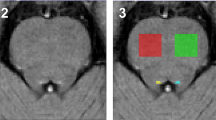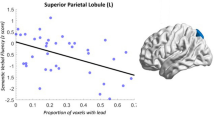Abstract
Diffuse axonal injury is a common pathological consequence of Traumatic Brain Injury (TBI). Diffusion Tensor Imaging is an ideal technique to study white matter integrity using the Fractional Anisotropy (FA) index which is a measure of axonal integrity and coherence. There have been several reports showing reduced FA in individuals with TBI, which suggest demyelination or reduced fiber density in white matter tracts secondary to injury. Individuals with TBI are usually diagnosed with cognitive deficits such as reduced attention span, memory and executive function. In this study we sought to investigate correlations between brain functional networks, white matter integrity, and TBI severity in individuals with TBI ranging from mild to severe. A resting state functional magnetic resonance imaging protocol was used to study the default mode network in subjects at rest. FA values were decreased throughout all white matter tracts in the mild to severe TBI subjects. FA values were also negatively correlated with TBI injury severity ratings. The default mode network showed several brain regions in which connectivity measures were higher among individuals with TBI relative to control subjects. These findings suggest that, subsequent to TBI, the brain may undergo adaptation responses at the cellular level to compensate for functional impairment due to axonal injury.
Similar content being viewed by others
Abbreviations
- ACC:
-
Anterior Cingulate Cortex
- BDI:
-
Beck Depression Inventory
- BISQ:
-
Brain Injury Screening Questionnaire
- CC:
-
Corpus Callosum
- DAI:
-
Diffusion Axonal Injuries
- DMN:
-
Default Mode Network
- DTI:
-
Diffusion Tensor Imaging
- FA:
-
Fractional Anisotropy
- fMRI:
-
Functional Magnetic Resonance Imaging
- ICA:
-
Independent Component Analysis
- ICBM:
-
International Consortium for Brain Mapping
- MCI:
-
Mild Cognitive Impairment
- MD:
-
Mean Diffusivity Maps
- MNI:
-
Montreal Neurological Institute
- PC:
-
Parietal Cortices
- PCC:
-
Posterior Cingulate Cortex
- TBI:
-
Traumatic Brain Injury
- TBSS:
-
Tract Based Spatial Statistics
- TFCE:
-
Threshold-Free Cluster Enhancement
References
Huisman T. A., Schwamm L. H., Schaefer P. W., Koroshetz W. J., Shetty-Alva N., Ozsunar Y. et al., Diffusion tensor imaging as potential biomarker of white matter injury in diffuse axonal injury, AJNR Am. J. Neuroradiol., 2004, 25, 370–376
Scheid R., Walther K., Guthke T., Preul C., von Cramon D. Y., Cognitive sequelae of diffuse axonal injury, Arch. Neurol., 2006, 63, 418–424
Kou Z., Wu Z., Tong K. A., Holshouser B., Benson R. R., Hu J. et al., The role of advanced MR imaging findings as biomarkers of traumatic brain injury, J. Head Trauma Rehabil., 2010, 25, 267–282
McDowell S., Whyte J., D’Esposito M., Working memory impairments in traumatic brain injury: evidence from a dual-task paradigm, Neuropsychologia, 1997, 35, 1341–1353
Arciniegas D. B., Held K., Wagner P., Cognitive Impairment Following Traumatic Brain Injury, Curr. Treat. Options Neurol., 2002, 4, 43–57
Schretlen D. J., Shapiro A. M., A quantitative review of the effects of traumatic brain injury on cognitive functioning, Int. Rev. Psychiatry, 2003, 15, 341–349
Hughes D. G., Jackson A., Mason D. L., Berry E., Hollis S., Yates D. W., Abnormalities on magnetic resonance imaging seen acutely following mild traumatic brain injury: correlation with neuropsychological tests and delayed recovery, Neuroradiology, 2004, 46, 550–558
Guskiewicz K. M., Marshall S. W., Bailes J., McCrea M., Cantu R. C., Randolph C. et al., Association between recurrent concussion and late-life cognitive impairment in retired professional football players, Neurosurgery, 2005, 57, 719–726
Basser P. J., Pajevic S., Pierpaoli C., Duda J., Aldroubi A., In vivo fiber tractography using DT-MRI data, Magn. Reson. Med., 2000, 44, 625–632
Wozniak J. R., Krach L., Ward E., Mueller B. A., Muetzel R., Schnoebelen S. et al., Neurocognitive and neuroimaging correlates of pediatric traumatic brain injury: A diffusion tensor imaging (DTI) study, Arch. Clin. Neuropsychol., 2007, 22, 555–568
Rutgers D. R., Toulgoat F., Cazejust J., Fillard P., Lasjaunias P., Ducreux D., White matter abnormalities in mild traumatic brain injury: a diffusion tensor imaging study, AJNR Am. J. Neuroradiol., 2008, 29, 514–519
Ogawa S., Lee T. M., Kay A. R., Tank D. W., Brain magnetic resonance imaging with contrast dependent on blood oxygenation, Proc. Natl. Acad. Sci. USA, 1990, 87, 9868–9872
McAllister T. W., Saykin A. J., Flashman L. A., Sparkling M. B., Johnson S. C., Mamourian A. C. et al., Brain activation during working memory 1 month after mild traumatic brain injury: a functional MRI study, Neurology, 1999, 53, 1300–1308
Scheibel R. S., Pearson D. A., Faria L. P., Kotrla K. J., Aylward E., Bachevalier J. et al., An fMRI study of executive functioning after severe diffuse TBI, Brain Inj., 2003, 17, 919–930
Azouvi P., Couillet J., Leclercq M., Martin Y., Asloun S., Rousseaux M., Divided attention and mental effort after severe traumatic brain injury, Neuropsychologia, 2004, 42, 1260–1268
Maruishi M., Miyatani M., Nakao T., Muranaka H., Compensatory cortical activation during performance of an attention task by patients with diffuse axonal injury: a functional magnetic resonance imaging study, J. Neurol. Neurosurg. Psychiatry, 2007, 78, 168–173
Haier R. J., Cerebral glucose metabolism and intelligence, In: Biological approaches to the study of human intelligence, Norwood, NJ: Ablex, 1993, 317–332
Tang C. Y., Eaves E. L., Ng J. C., Carpenter D. M., Kanellopoulou I., Mai X. et al., Brain networks for working memory and factors of intelligence assessed in males and females with fMRI and DTI, Intelligence, 2010, 38, 293–303
Greicius M. D., Krasnow B., Reiss A. L., Menon V., Functional connectivity in the resting brain: A network analysis of the default mode hypothesis, Proc. Natl. Acad. Sci. USA, 2003, 100, 253–258
Damoiseaux J. S., Rombouts S. A., Barkhof F., Scheltens P., Stam C. J., Smith S. M. et al., Consistent resting-state networks across healthy subjects, Proc. Natl. Acad. Sci. USA, 2006, 103, 13848–13853
De Luca M., Beckmann C. F., De Stefano N., Matthews P. M., Smith S. M., fMRI resting state networks define distinct modes of longdistance interactions in the human brain, Neuroimage, 2006, 29, 1359–1367
MacDonald C. L., Schwarze N., Vaishnavi S. N., Epstein A. A., Snyder A. Z., Raichle M. E. et al., Verbal memory deficit following traumatic brain injury: assessment using advanced MRI methods, Neurology, 2008, 71, 1199–1201
Nakamura T., Hillary F. G., Biswal B. B., Resting network plasticity following brain injury, Plos One, 2009, 4, e8220
Smith S. M., Jenkinson M., Johansen-Berg H., Rueckert D., Nichols T. E., Mackay C. E. et al., Tract-based spatial statistics: voxelwise analysis of multi-subject diffusion data, Neuroimage, 2006, 31, 1487–1505
Smith S. M., Nichols T. E., Threshold-free cluster enhancement: addressing problems of smoothing, threshold dependence and localisation in cluster inference, Neuroimage, 2009, 44, 83–98
Beckmann C. F., Smith S. M., Probabilistic independent component analysis for functional magnetic resonance imaging, IEEE Trans. Med. Imaging, 2004, 23, 137–152
Benson R. R., Meda S. A., Vasudevan S., Kou Z., Govindarajan K. A., Hanks R. A. et al., Global white matter analysis of diffusion tensor images is predictive of injury severity in traumatic brain injury, J. Neurotraum., 2007, 24, 446–459
Xu J., Rasmussen I. A., Lagopoulos J., Håberg A., Diffuse axonal injury in severe traumatic brain injury visualized using high-resolution diffusion tensor imaging, J. Neurotraum., 2007, 24, 753–765
Nobuhara K., Okugawa G., Sugimoto T., Minami T., Tamagaki C., Takase K. et al., Frontal white matter anisotropy and symptom severity of late-life depression: a magnetic resonance diffusion tensor imaging study, J. Neurol. Neurosurg. Psychiatry, 2006, 77, 120–122
Herrmann L. L., Le Masurier M., Ebmeier K. P., White matter hyperintensities in late life depression: a systematic review, J. Neurol. Neurosurg. Psychiatry, 2008, 79, 619–624
Greicius M. D., Srivastava G., Reiss A. L., Menon V., Default-mode network activity distinguishes Alzheimer’s disease from healthy aging: Evidence from functional MRI, Proc. Natl. Acad. Sci. USA, 2004, 101, 4637–4642
Sorg C., Riedl V., Mühlau M., Calhoun V. D., Eichele T., Läer L. et al., Selective changes of resting-state networks in individuals at risk for Alzheimer’s disease, Proc. Natl. Acad. Sci. USA, 2007, 104, 18760–18765
Liang M., Zhou Y., Jiang T., Liu Z., Tian L., Liu H. et al., Widespread functional disconnectivity in schizophrenia with resting-state functional magnetic resonance imaging, Neuroreport, 2006, 17, 209–213
Cherkassky V. L., Kana R. K., Keller T. A., Just M. A., Functional connectivity in a baseline resting-state network in autism, Neuroreport, 2006, 17, 1687–1690
Haier R. J., Siegel B. V. Jr., MacLachlan A., Soderling E., Lottenberg S., Buchsbaum M. S., Regional glucose metabolic changes after learning a complex visuospatial motor task — a positron emission tomographic study, Brain Res., 1992, 570, 134–143
Davis S. W., Dennis N. A., Daselaar S. M., Fleck M. S., Cabeza R., Que PASA? The posterior-anterior shift in aging, Cereb. Cortex, 2008, 18, 1201–1209
Damoiseaux J. S., Prater K. E., Miller B. L., Greicius M. D., Functional connectivity tracks clinical deterioration in Alzheimer’s disease, Neurobiol. Aging, 2011, epub ahead of print
Qi Z. G., Wu X., Wang Z., Zhang N., Dong H., Yao L. et al., Impairment and compensation coexist in amnestic MCI default mode network, Neuroimage, 2010, 50, 48–55
Author information
Authors and Affiliations
Corresponding author
About this article
Cite this article
Tang, C.Y., Eaves, E., Dams-O’Connor, K. et al. Diffuse disconnectivity in traumatic brain injury: a resting state fMRI and DTI study. Translat.Neurosci. 3, 9–14 (2012). https://doi.org/10.2478/s13380-012-0003-3
Received:
Accepted:
Published:
Issue Date:
DOI: https://doi.org/10.2478/s13380-012-0003-3




